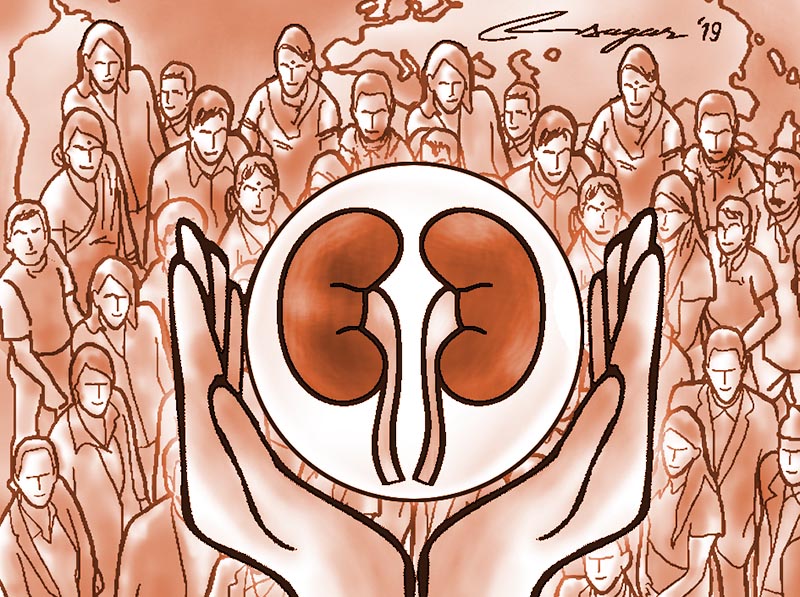Kidney health for everyone: Focus on prevention
Organ failure can be prevented through routine health examination, lifestyle modification, early diagnosis and treatment. The importance of these can be highlighted by creating awareness
The world is celebrating World Kidney Day today with the aim of raising awareness about the increasing burden of kidney diseases worldwide and the need for strategies to prevent and manage them. Besides the heart, trauma, cancer and other organ diseases, kidney diseases are rising alarmingly, and are a major cause of mortality.
At least 2.4 million people die every year due to chronic kidney diseases (CKD) and are now the 6th fastest growing cause of death. Similarly, acute kidney injury (AKI), an important driver of CKD, affects more than 13 million people worldwide. Moreover, CKD and AKI significantly contribute to increased morbidity and mortality from other diseases, such as cardiovascular disease, diabetes, hypertension, obesity, HIV infection, malaria and tuberculosis.
Though the burden of kidney diseases is alarming, this has not yet drawn enough attention. CKD and AKI are often found in people who are born into poverty, face gender discrimination, lack education, and work in hazardous occupations and pollution.
Transplantation is considered the gold standard and most cost-effective treatment of CKD. But it not only requires high set-up costs for infrastructure and a multidisciplinary team of highly specialised manpower, it also cannot be done without organ donors and dialysis backup. Lack of physical facilities and laws as well as cultural bias against organ donation present barriers in countries like ours, making dialysis the default option.
In general, there are national policies and strategies for non-communicable diseases (NCDs) in many countries, but specific policies directed toward screening, prevention and treatment of kidney diseases are often lacking.
Statistics reveal that nearly 3,000 people in Nepal develop kidney failure annually. Similarly, the number of people taking dialysis services across the country is around 4,500, whilst the number of kidney transplants has reached nearly 1,300. The kidney transplant is emerging as the best modality of treatment as it offers a better quality of life than dialysis.
Currently, there are three government hospitals licensed to conduct kidney transplantation. The Shahid Dharmabhakta National Transplant Centre (SDNTC) in Bhaktapur has already conducted 586 kidney transplants over six years with world class results. Likewise, there are nearly 120 patients taking free dialysis services every day. This centre is also the pioneer in liver transplant and brain dead donor kidney transplant in the country, having done six kidney transplants and one liver transplant from three deceased donors till date. Aimed at conducting 200 kidney transplants this fiscal year, the centre has already conducted 161 live donor kidney transplants in the last eight months. This has already saved the country billions of rupees.
Kidney transplantation is tied with strict legal provisions. The old Organ Transplant Act of Nepal allowed only living donor kidney transplantation, and the donor pool was extremely narrow. However, the new Organ Transplant Act of Nepal, 2072 has introduced new provisions, making it more flexible to get donors for transplantation. The three provisions are: Expansion of live donor pool, namely relatives. The second provision is, pair-exchange, where an incompatible donor/ recipient pair is matched with another incompatible donor/ recipient pair for a “swap” from different families.
The third provision is brain-death organ donation and transplantation. One brain-dead person can donate eight solid organs. In Nepal, the number of people sustaining brain-deaths is quite high, especially from road traffic accidents, but due to lack of awareness and various social and religious factors, the rate of brain-death organ donation and transplantation is still low.
Though the main focus of clinical science lies on the curative aspect, it is high time we concentrated on disease prevention. This will reduce the overcrowding of hospitals and grapple with the shortage of human and other resources. Organ failure can be prevented through routine health examination, lifestyle modification, early diagnosis and treatment. The importance of these can be highlighted by creating awareness.
In the last one decade, Nepal has become successful in reaching many milestones in the orbit of transplantation, and there is a lot more to achieve through collective efforts. So the SDNTC, jointly with the Nepalese Society of Organ Transplantation (NESOT) and Indian Society of Organ Transplantation (ISOT), is organising the 1st International Transplant Conference with the theme “Bridging the Gap” on April 20-21 in Kathmandu.
This year’s theme for World Kidney Day “Kidney Health for Everyone Everywhere” calls for universal health coverage (UHC) for the prevention and early treatment of kidney disease.
This can be achieved by adopting a healthy lifestyle through access to clean water, exercise, a healthy diet and tobacco control. Screening for kidney diseases should be made a primary healthcare intervention, including access to identification tools, such as urine and blood tests. And as more resources become available, there is a need for transparent policies governing access to advanced health care services, such as dialysis and transplantation, and better financial protection, such as subsidies.
Dr Shrestha is kidney and liver transplant surgeon at SDNTC






